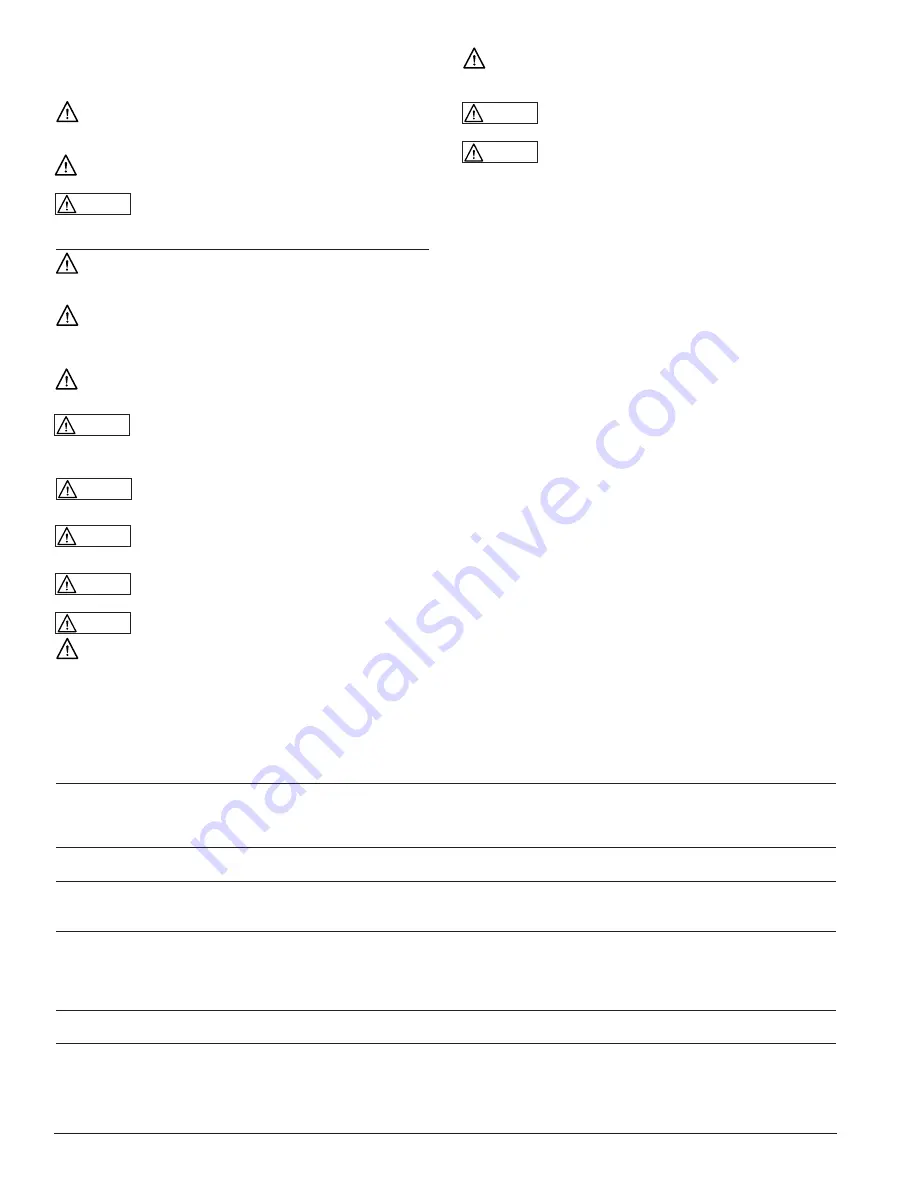
GENERAL SAFETY INFORMATION
Follow all safety codes and the Occupational Safety and
Health Act (OSHA).
These User Instructions contain specific safety markings
where non-observance of an instruction would cause hazards.
The specific safety markings are:
This symbol indicates safety instructions where non-compliance
would affect personal safety and could result in serious injury.
This symbol indicates safety instructions where non-
compliance will involve some risk to safe operation and personal
safety and would damage the equipment and or property.
Do NOT pump
Gasoline or flammable fluids with flash
point below 98°F (37°C) Explosion or serious injury may occur.
Incompatible fluids may cause premature failure of the
pump. It is the customer’s responsibility to ensure that
fluids are compatible with pump materials.
If used with
C02 or N2
be sure the area is well
ventilated.
If pump is to be used in high flow, low pressure
applications, adjust air pressure to 20 PSI (1.38 bar) above
discharge pressure.
Do NOT
Exceed 100 PSI (6.9 bar) Air Inlet
Pressure.
Continuous operation above 120
°
F (48.9
°
C)
will reduce pump life.
Inlet air must be dry and oil free - use an air/oil
filter and air dryer.
Mount with ports facing down.
To Reduce the risk of static sparking, ground the pump
and all other equipment used or located in the pumping
area. Check your local electrical code for detailed
grounding instructions for your area and type of equipment.
TROUBLESHOOTING CHART
Symptom
Possible Cause(s)
Corrective Action
Pump will not start (stalls)
1. Inadequate air supply (20 PSI Min.)
1. Increase air inlet pressure
2. Contaminated air supply
2. An air dryer might be required
3. Ruptured diaphragm (2)
3. Replace diaphragm (2)
4. Check shuttle valve for wear (11)
4. Replace shuttle valve if necessary (11)
Pump runs, but no fluid
1. A leak or break in the product inlet line
1. Replace product line
2. A leak or break in the product discharge line
2. Replace product line
Pump leaks through exhaust port
1. Leak at upper exhaust port o-ring (13)
1. Replace exhaust port (13)
2. Shaft seal o-rings damaged or worn
2. Replace shaft seal o-rings
3. Inadequate slide lubrication
3. Replace with shuttle valve kit
Flow rate is low
1. Tubing or hose is damaged or blocked
1. Clean or replace
2. Check viscosity of medium being pumped
2. Reduce viscosity of medium, increase
hose diameter or contact factory for
recommendation
3. Check valves not seated correctly (6)
3. Reinstall check valves (6)
Pump leaks
1. Ruptured or worn out diaphragm (2)
1. Replace diaphragm (2)
2. Pump housing screws not torqued adequately
2. Torque screws to 20 in lb
C
FLOJET warrants this product to be free of defects in
material and/or workmanship for a period of one year after
purchase by the customer from FLOJET. During this one
year warranty period, FLOJET will at its option, at no charge
to the customer, repair or replace this product if found
defective, with a new or reconditioned product, but not to
include costs of removal or installation. No product will be
accepted for return without a return material authorization
number. All return goods must be shipped with
transportation charges prepaid. This is only a summary of
our Limited Warranty. For a copy of our complete warranty,
please request Form No. 100-101.
RETURN PROCEDURE
Prior to returning any product to FLOJET, call customer
service for an authorization number. This number must be
written on the outside of the shipping package. Place a note
inside the package with an explanation regarding the
reason for return as well as the authorization number.
Include your name, address and phone number.
WARRANTY
When using high pressure gas tanks make sure a
secondary regulator is used to avoid accidental damage to
pump.
Do not clean or service FLOJET pumps,
hoses or valves while the system is pressurized.
This is not a submersible pump - use only in
dry environments.
PREVENTIVE MAINTENANCE TIPS
Tips to help prolong your pump’s life.
• If pumping liquid other than water, pump should be
flushed with water (if applicable) after every use.
• Before freezing conditions occur, pump must be liquid free.
• If mounting pump in an outdoor environment, shield
pump from environmental extremes (i.e. sunlight, water
from washdown spray, rain, etc.). Avoid high heat and
humid installations.
• When using an air compressor, use an inline air dryer
(PN# FJ520B) before the pump to limit water build-up.
CAUTION
CAUTION
CAUTION
CAUTION
CAUTION
CAUTION
CAUTION
CAUTION
For more information visit us
online at www.flojet.com






















